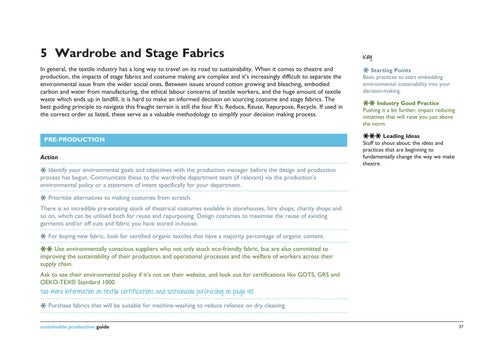5 Wardrobe and Stage Fabrics In general, the textile industry has a long way to travel on its road to sustainability. When it comes to theatre and production, the impacts of stage fabrics and costume making are complex and it’s increasingly difficult to separate the environmental issue from the wider social ones. Between issues around cotton growing and bleaching, embodied carbon and water from manufacturing, the ethical labour concerns of textile workers, and the huge amount of textile waste which ends up in landfill, it is hard to make an informed decision on sourcing costume and stage fabrics. The best guiding principle to navigate this fraught terrain is still the four R’s; Reduce, Reuse, Repurpose, Recycle. If used in the correct order as listed, these serve as a valuable methodology to simplify your decision making process.
PRE-PRODUCTION Action Identify your environmental goals and objectives with the production manager before the design and production process has begun. Communicate these to the wardrobe department team (if relevant) via the production’s environmental policy or a statement of intent specifically for your department.
Key Starting Points Basic practices to start embedding environmental sustainability into your decision-making. Industry Good Practice Pushing it a bit further; impact reducing initiatives that will raise you just above the norm. Leading Ideas Stuff to shout about; the ideas and practices that are beginning to fundamentally change the way we make theatre.
Prioritise alternatives to making costumes from scratch. There is an incredible pre-existing stock of theatrical costumes available in storehouses, hire shops, charity shops and so on, which can be utilised both for reuse and repurposing. Design costumes to maximise the reuse of existing garments and/or off cuts and fabric you have stored in-house. For buying new fabric, look for certified organic textiles that have a majority percentage of organic content. Use environmentally conscious suppliers who not only stock eco-friendly fabric, but are also committed to improving the sustainability of their production and operational processes and the welfare of workers across their supply chain. Ask to see their environmental policy if it’s not on their website, and look out for certifications like GOTS, GRS and OEKO-TEX® Standard 1000. See more information on textile certifications and sustainable purchasing on page 40. Purchase fabrics that will be suitable for machine-washing to reduce reliance on dry cleaning. sustainable production guide – Measure and manage your carbon emissions
37







